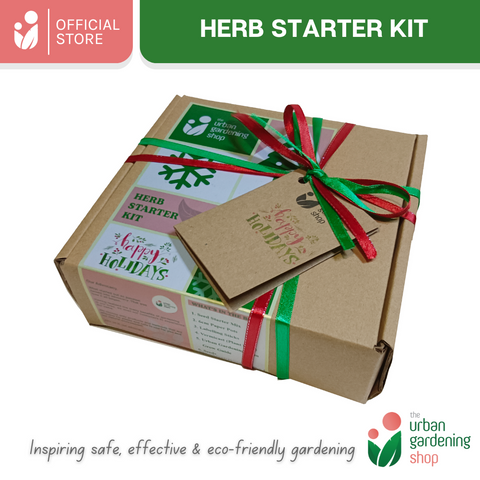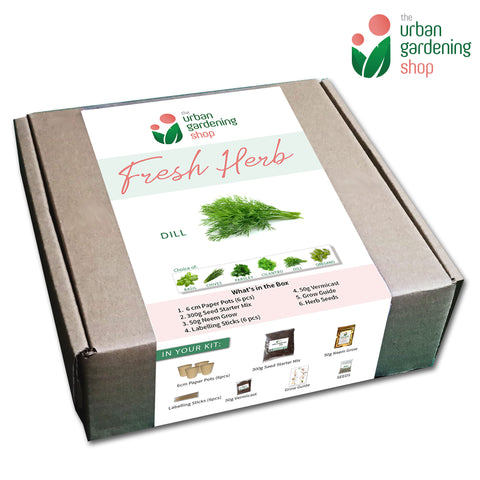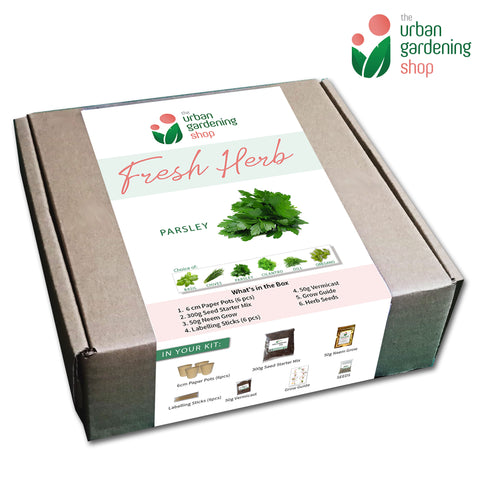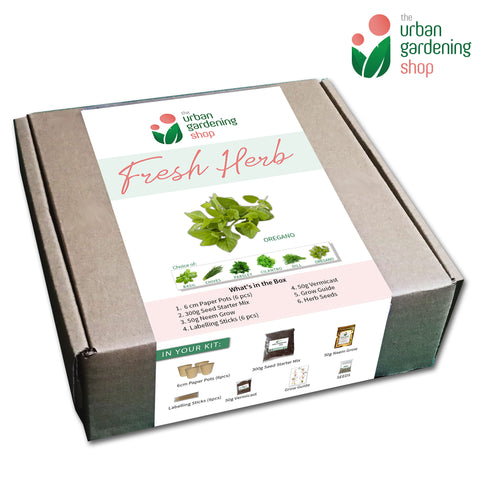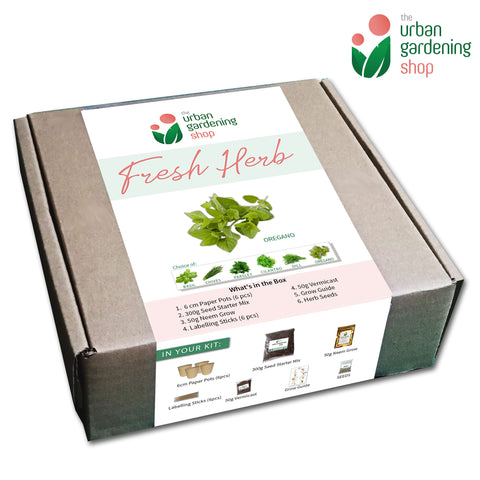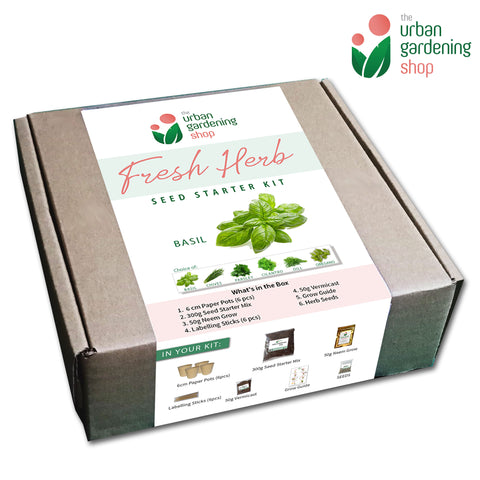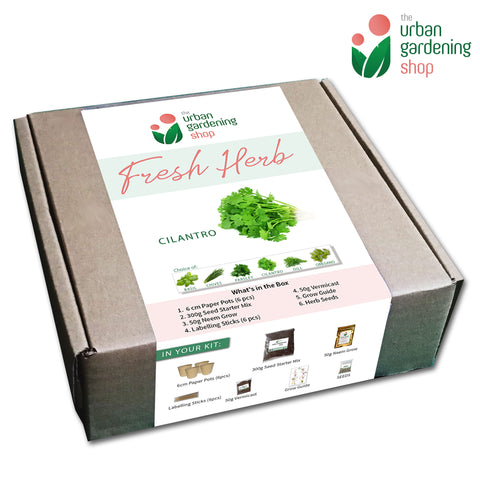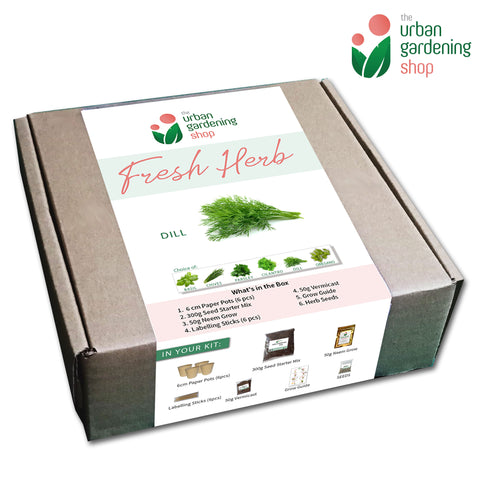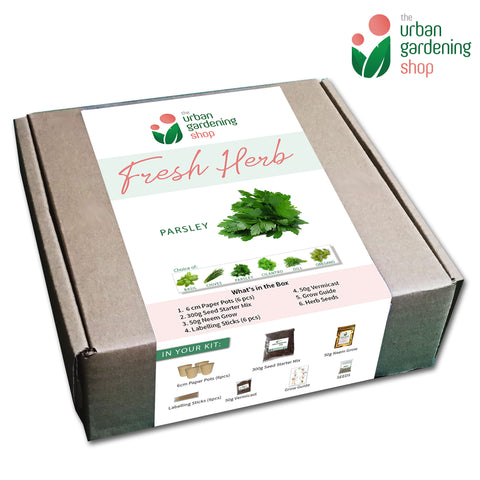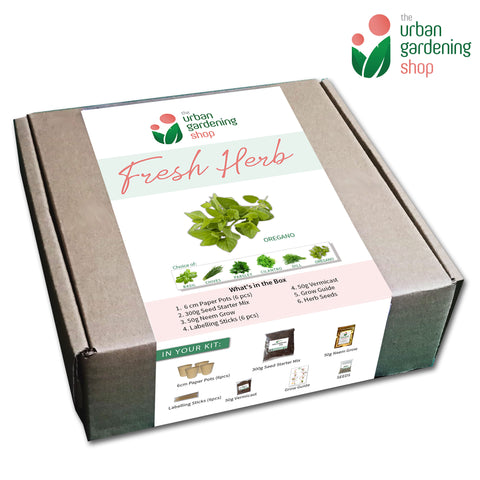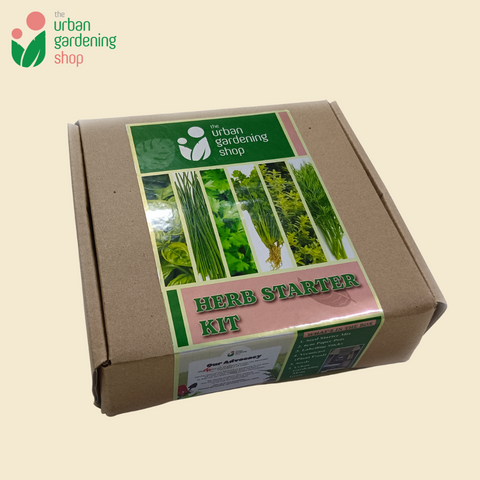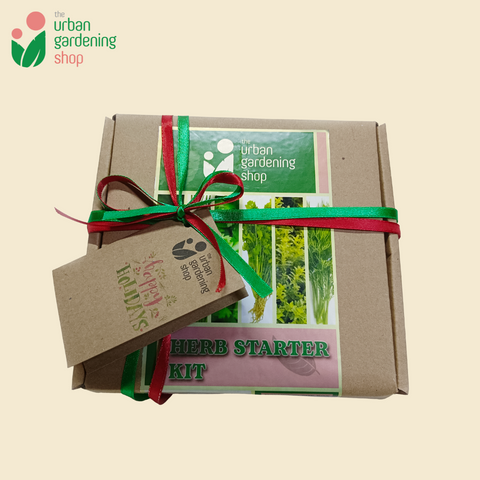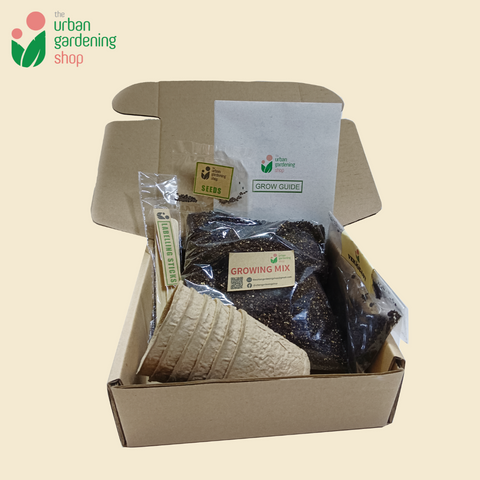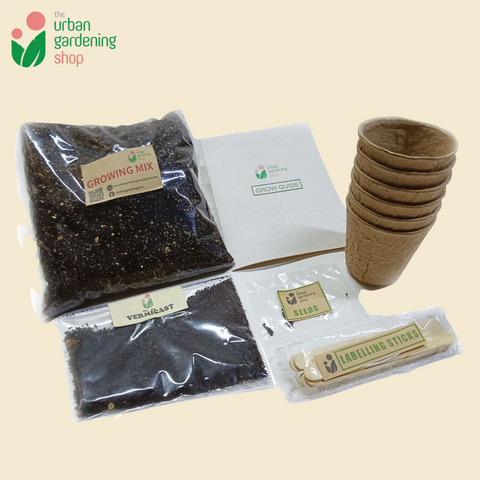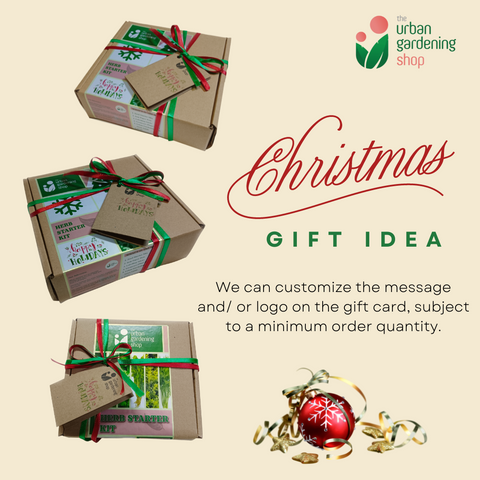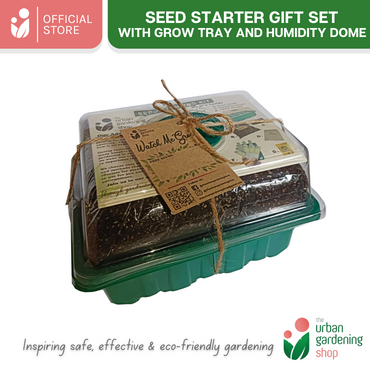
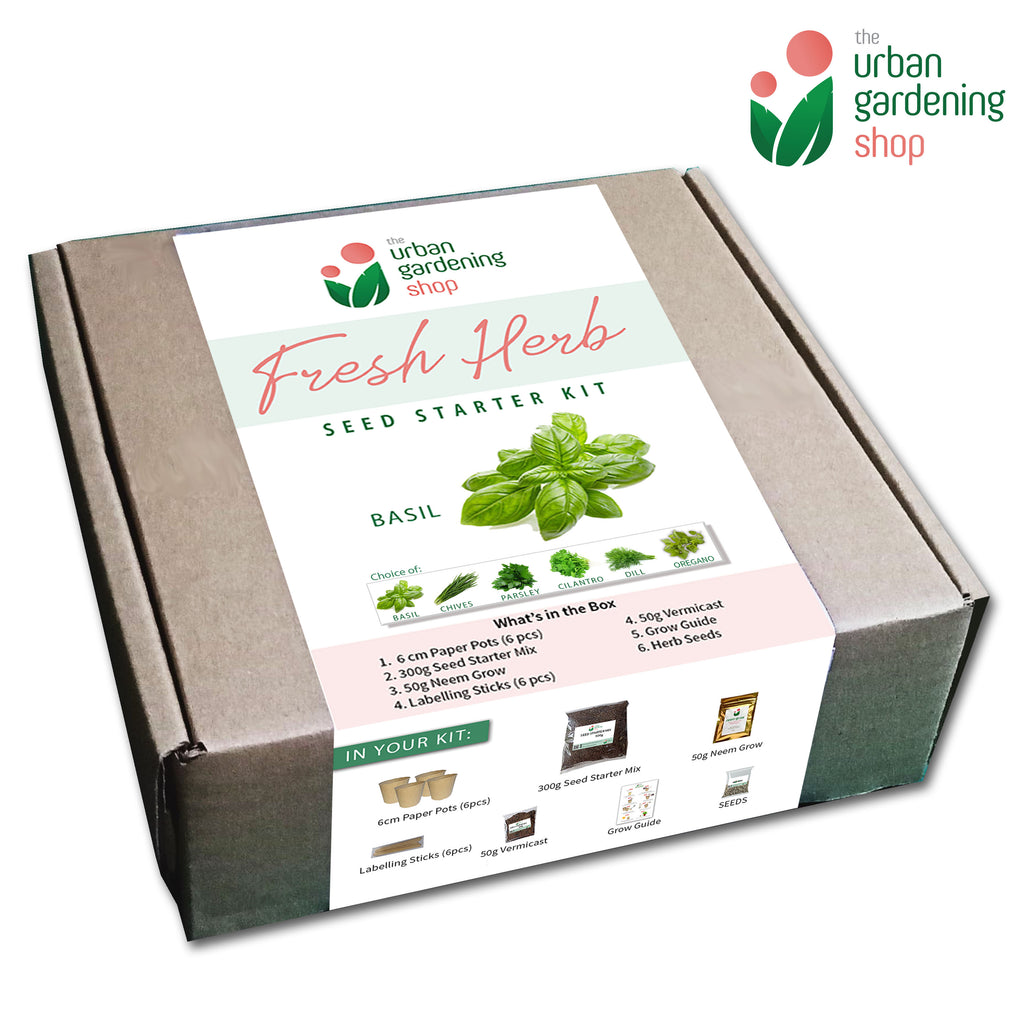
HERB SEED STARTER KITS by The Urban Gardening Shop
₱ 320.00 ₱ 400.00
HERB SEED STARTER KIT
Start your herb garden now!
What’s Inside:
- Growing Mix
- Pulp Paper Pots (6)
- Plant Nutrients
- Labeling Sticks ...
HERB SEED STARTER KIT
Start your herb garden now!
What’s Inside:
- Growing Mix
- Pulp Paper Pots (6)
- Plant Nutrients
- Labeling Sticks
- Seeds
- Grow Guide
Choice of: Basil, Chives, Parsley, Cilantro, Dill and Oregano
Grow them all!
GROW GUIDE
Step ONE
Fill the paper pots with Growing Mix, followed by the Plant Nutrients (1 tbsp each).
Mix lightly and tap the pots to even out the air pockets.
Step TWO
Gently water the pots until all portions are moist (but not too soaked).
Wait until all excess liquid drains out at the bottom.
Step THREE
Drop 2- 3 seeds at the center.
Cover seeds with a thin layer of Growing Mix and then water lightly.
Step FOUR
Using a permanent marker, write the name of the seeds and date on the sticks.
Stick them one by one into each pot.
Step FIVE
Leave the pots beside a well-lit window.
Water when the top part gets dry.
Step SIX
When the 4th leaf appears, start exposing the seedlings to sunlight.
Step SEVEN
Transfer to a bigger pot 1 month after sprouting.
PLANT CARE TIPS
BASIL
Basil is one of the easiest herbs to grow in our local environment. While seeds start slow, they usually gain momentum and grow faster after the 4th or 5th leaf starts to appear. There are several varieties of basil, but the most popular among them is the Genovese or Italian Basil. This type of basil is used in many pasta and pizza recipes.
To grow lush basil, give them lots of sunlight. When the plant reaches about a foot in height, start pruning the top every three weeks. To prune, cut off the top leaves down to the 2nd or 3rd leaf node. This encourages more branches and leaves to grow.
Basil grows well in any medium-sized container. When transplanting to a pot, use a well-draining soil or potting media. Fertilize with organic nutrients at least once a month. Do not allow the soil or potting media to run completely dry. Water every other day, or at least three times a week.
CHIVES
Chives grow well even with minimal care. They like moist soil, which make them perfectly suited to our tropical weather. They grow well in any medium sized container. For healthier leaves, expose them to lots of sunshine.
Chives can survive even when neglected. Harvest chives by cutting the upper leaves, leaving about 2 inches of the bottom part. They will continue to grow new leaves, even with regular harvesting. When the weather is hot, they grow flowers. Both chives leaves and flowers are all edible. Chop them finely and use as topping for eggs, steamed vegetables and even rice.
Chives are a perennial, which means that they can last for several years. Repot every 2 years, and add more soil or potting mix as needed. Fertilize with a rich organic plant nutrients every 3 months.
CILANTRO
Like most leafy herbs, cilantro does not occupy too much space and is therefore ideal for container gardening. A medium-sized pot of around 6 – 8 inches in depth and diameter is sufficient to grow cilantro plants. Fertilize the soil by mixing in some organic compost material into the soil. Ensure that the soil is always moist (not soggy), and water the plants regularly.
Cilantro needs only a few hours of sun in the morning. To keep soil temperature low, provide dappled shade by strategically locating the pot beside other taller plants that can serve as a natural shield from the hot afternoon sun. During summer, move the pot to a shady part of the garden that still gets a lot of indirect sunlight.
To harvest, cut mature leafy stems starting with the outermost ones. For continued harvests, do not cut more than 50% of the stems per round. Cilantro is an annual, and it usually has a life span of 4 to 6 months from sowing.
PARSLEY
Parsley is packed with more vitamins and minerals than any other culinary herb. It is a biennial -which means that it lasts for about 2 years. When it starts to produce flowers, this usually signals the end of its life cycle.
Propagating parsley is easy using seeds. It requires consistently moist but loose and well-draining soil or potting media. An occasional side-dressing of plant nutrients is needed at least once a month.
During hot months. Locate the plant under a partially shady area, that still gets around 3-4 hours of sun exposure. It cannot tolerate excessive drought, so never allow the potting media to dry up completely. Use a well-draining pot, to prevent root rot.
When harvesting, cut the leaves and stalks starting at the sides, leaving the core largely intact. Do not harvest more than 50% of the stalks and leaves.
DILL
Dill grows best in rich moist soil. Use medium-sized well-draining pots. Keeping the soil moist is important. Water every 2-3 days, or more often, if the soil feels dry. Add compost or any organic plant nutrients every 3 or 4 weeks. Do not overfertilize, as too much fertilizer may cause it to lose its aroma.
To harvest dill, trim the outer and more mature leaves. Dill is ready to harvest within 3 months from sowing, when the plant has reached at least 8 inches. Dill grows slowly in the first two months. For faster growth, expose it to more sunlight.
The dill’s life spans only for a year (more or less). In the first six months, its flavor and aroma are concentrated in the leaves. Once the plant starts to flower, the leaves will begin to lose their flavor. At this stage, harvest the seeds after the flowers have bloomed and are about to change their color.
OREGANO
OREGANO is a culinary herb that has an earthy sweet aroma. It is used alone or in combination with other herbs like basil and oregano to enhance the flavor or aroma of pasta and other meat dishes.
It is generally easy to grow and propagate. It grows well in any medium sized container or pot. Avoid over-watering by using a well-draining pot and a good quality potting media. During summer, water more often when the soil feels dry. While it is moderately drought-tolerant, do not allow the soil or potting media to dry up completely.
Apply plant nutrients in moderation, once a month. Prune the top leaves regularly. Pruning encourages the plant to produce more leaves. For lusher leaves, expose to at least 4 hours of sunlight per day. Oregano is a perennial, which means that it lasts for several years. To prolong its life, repot every 2 years.

